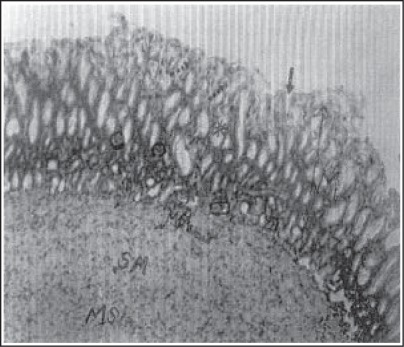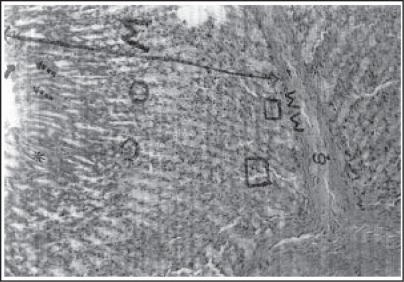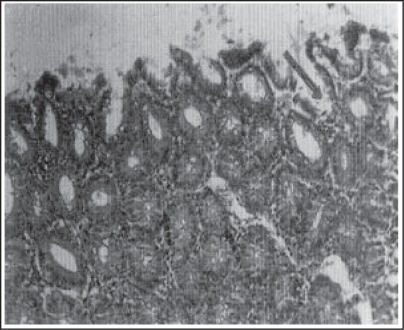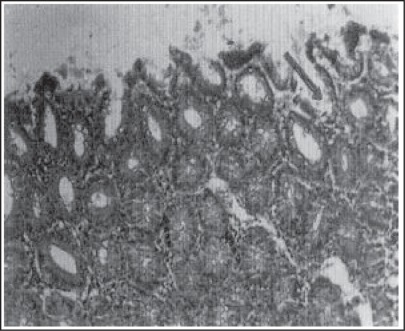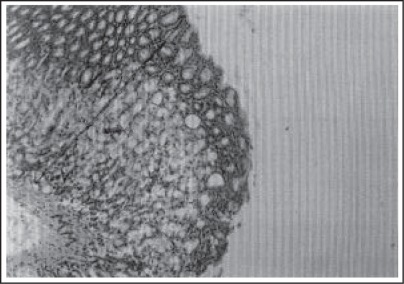Abstract
Heliotropium indicum of the family Boraginaceae is used locally in Nigeria to treat ailments such as ulcer and fever. In this study, ulceration of the gastric mucosa in Wistar rats was induced via the oral administration of 80mg/kg/bodyweight of Indomethacin. Histological analyses of the stomach body wall in the rats of Groups 2 and 4 (which received 100mg/kg/bodyweight of extract before oral administration of 80mg/kg/bodyweight Indomethacin and 80mg/kg/bodyweight Indomethacin only respectively) showed erosion of the mucus-secreting cells, gastric pit, upper and middle parts of gastric glands and some of the parietal cells. Histological observations of the stomach body wall in rats of Group 5 (which received 200mg/kg/bodyweight of extract before oral administration of 80mg/kg/bodyweight of Indomethacin) showed erosion of the mucus-secreting cells, gastric pit and the upper most part of the gastric gland. Histological observations of the stomach body wall in rats of Groups 1, 6 and 3 (which received 50mg/kg/bodyweight of Ranitidine and 400mg/kg/bodyweight of extract before oral administration of 80mg/kg/bodyweight Indomethacin; and only 80mg/kg/bodyweight of Normal Saline respectively) showed normal morphological appearance of the different components of the mucosa layer. Thus, the aqueous extracts of the dried leaves of Heliotropium indicum have dose dependent histo-gastroprotective effects.
Keywords: Heliotropium Indicum, Ulcerated Gastric Mucosa, Histo-Gastroprotective Effects
Introduction
Peptic ulcer occurs in that part of the gastro intestinal tract which is exposed to gastric acid and pepsin, i.e. the stomach and duodenum. The etiology is not clearly known. It results probably from an imbalance between aggressive (acid, pepsin and H. pylori infection) and defensive (gastric mucus and bicarbonate secretion, prostaglandins, nitric oxide, innate resistance of the mucosal cells) factors; as well as factors such as genetic, psychosomatic, humoral and vascular derangements. (1, 2) Pathological examination of gastric ulcer could be evaluated in any part of the stomach, but is most commonly obtained from the lesser curvature. Histologically, there is a break in the superficial epithelium penetrating down to the muscularis mucosa with a fibrous base and an increase in inflammatory cells. (1, 2)
Heliotropium indicum belongs to the family Boraginaceae. Other species of Heliotropium include Heliotropium bacciferum, Heliotropium ovalifolium and Heliotropium pterocarpum (3). It grows up to 80cm high with a pleasant aroma. Its stems and leaves are covered with a fine hairy layer, and its flowers are small and grow in clusters which curve in on themselves at the tips. (3) It is found in tropical and non-tropical countries bearing various names, such as Cock’s comb (Gambia), Indian heliotrope, herbe a verrues (France), Heliotropioin-Indiano (Portugal) and Agogo Igun or Ogbe Akuko (Yoruba-Nigeria). (3) Its chemical components include pyrolizidine Alkaloids, Indicine-N-Oxide, Tannins, Saponins and Heliotrine. (3) Its alkaloid component confers on it antiinflammatory, wound healing, antiseptic/antimicrobial, febrifuge, secretagogue stimulation (of gall bladder functions) and menstruation activator properties. (3, 4). Its most important local application is for skin lesions, wounds, abscesses, gastric and varicose ulcerations, rashes and warts, though it takes many days for the plant to eliminate them. (3, 4) Indicine-N-Oxide shows no marked hepatotoxicity but possesses significant anti-tumour activity. It also showed substantial activity in leukemia, but hepatotoxicity was more severe than expected and the cause is not known. (3, 4)
This study investigated the histo-gastroprotective effects of Heliotropium Indicum on indomethacin – induced gastric ulcerations in adult male wistar rats. This is to scientifically confirm earlier observations that the plant (as used locally) could treat gastric ulcerations (3, 4).
Materials and Methods
Heliotropium indicum L. (Boraginaceae) was collected in Sagamu, Ogun State in the South West of Nigeria. The plant was identified and authenticated by Mr. Usang Felix of the Forest Research Institute of Nigeria Ibadan. The authenticated plant has the Voucher number FHI 107093.
Experimental Animals
Wistar rats weighing between 75 – 150g were obtained from the colony bred of Nigeria Institute of Medical Research (NIMAR), Ibadan, Oyo State, Nigeria. Animals were fed during the experiment with Growers Feed from Bendel Feed and Flour Mill Ltd., Nigeria. The animals were caged under standard condition in a well ventilated animal house of the Faculty of Pharmacy, Olabisi Onabanjo University, and Ogun State, Nigeria at room temperature 25°C with water supplied ad libitum to the rats.
Preparation of Plant Extracts
The leaves of Heliotropium indicum Linn Boraginaceae were air dried for 5 days under shade and powdered using a laboratory blender. 300g of the powdered leaf was soaked in 1.5 litres of water for 5 days. It was then filtered using Whitman filter paper No 1. The filtrate was collected in a beaker and evaporated to dryness on a hot plate set at 60°C. The yield was collected and the filtrate kept under suitable conditions (10°C to 20°C) for further bioactivity studies (Table 1).
Table 1 :
Phytochemical analyses
| TEST | RESULTS |
|---|---|
| SECONDARY METABOLITIES | |
| (1) Alkaloids tests: | |
| a. Wagner | + |
| b. Mayer | + |
| c. Picric acid | + |
| (2) Anthracene derivatives | |
| Test for Free Anthraquinones | − |
| Test for Combined Anthraquinones | − |
| Test for Anthracene derivatives which are resistant to mild hydrolysis | − |
| (3) Test for Saponins | + |
| (4) Test for Tannins | + |
| (5) Test for Cardiac glycosides | − |
| (6) Test for Carbhoydrate | − |
KEY:
+ Positive Result
− Negative Result
Phytochemical Evaluationns
Test for Flavonoids
2g of the liophilized sample was re-dissolved in water for 5 minutes and filtered. The filtrate was collected in a test tube; then, 5 drops of 5% sodium hydroxide were added followed by addition of 2ml of 10% Hydrochloric acid. (5)
Test for Saponins
1g of the powdered sample of Helitropium indicum was boiled with 10mls distilled water for 10 minutes and filtered while hot, then allowed to cool. 2.5ml of the filtrate was diluted with 10ml of water and shaken properly, and then two drops of castor oil were added to the solution and shaken vigorously for 2 minutes. (5) The results was positive, there was frothing and a stable emulsion was formed.
Test for Cardiac Glycosides
1g of the powdered sample were boiled with 10mls of 80% alcohol for 5 minutes on a water bath and filtered. The cooled filtrate was diluted with equal volume of distilled water and a few drop of lead acetate was added and shaken thoroughly. This was allowed to stand for some minutes and then filtered. The filtrate was extracted with 2 volumes of chloroform and the combined extracts were concentrated to form a residue that was used for Keller Kiliani and Kedde tests. (6)
Keller-Kiliani’s Test:
A portion of chloroform extracts was dissolved in ferric reagent (0.3ml 10% ferric chloride in 50% glacial acetic aced) in clean test tubes. 2ml of concentrated sulphuric acid was carefully poured down the side of the test tube so as to form a layer below the acetic acid solution. The formation of a purple, reddish brown or brown ring at the interphase and green colour in the acetic acid layer are characteristic of cardenolides. The test is used for the detection of 2 deoxy-sugar. (6)
Kedde’s Test:
The second portion of the extract was mixed with 1ml of 3, 5-dinitrobenzoic acid in ethanol. The resulting solution was made alkaline by adding 5% NaOH dropwise. The formation of a brown-purple colour indicates the presence of unsaturated lactone rings of sesquiterpenes. (6, 7)
Test for Tannins
About 0.5g of the powdered leaf samples was boiled with 10ml of distilled water for 5 minutes filtered while hot and cooled. The filtrate was adjusted to 20ml with distilled water. An alliquot (1.0ml) of the filtrate above was further diluted with distilled water to 5ml, after which a few drops of 0.1% ferric chloride solution was added. A bluish-black or greenish colour indicates a positive test. (5) The result was positive.
Test for Anthraquinones
Combined Anthraquinones: 0.5g of the powdered leaf was boiled with 10mls of HCL (1%) for 5 minutes, filtered whilst hot and the filtrate allowed to cool. The cooled filtrate was then partitioned against equal volume of chloroform. The chloroform layers were carefully transferred into a clean test tube, shaken with an equal volume of 10% ammonia solution and the layer allowed to separate. The observation of a delicate rose pink colour indicates the presence of combined anthraquinone (O-glycoside). (5). The result was negative.
Free Anthraquinone: 0.5g of the powdered leaf samples was placed in a dry test tube, 5ml of chloroform added and shaken for 5minutes. The extracts were then filtered and the filtrate shaken with equal volume of 10% ammonia (obtained from Pharmacognosy’s Laboratory of Olabisi Onabanjo University). The observation of a bright pink colour in the aqueous layer indicates the presence of free anthraquinones (a-glycone). (5). The result was negative.
Evaluation of Histo-Gastroprotective effect of Heliotropium Indicum Linn Boraginaceae
Feeding of the animals was terminated 24 hours before the commencement of the experiment. The animals were, however, allowed free access to water and were then randomly divided into six treatment groups of four rats each. Crude aqueous extract of Heliotropium indicum (100, 200 and 400mg/kg/bodyweight) was administered orally to three groups of rats (Groups 4, 5 and 6 respectively); 50mg/kg/bodyweight of Ranitidine was administered orally to rats in one group as the standard control group (Group 1), 80mg/kg/bodyweight of Indomethacin was administered orally to rats in Group 2 and 80mg/kg/bodyweight of Normal Saline was administered orally to rats in Group 3 as the control group. One hour after administration of the extract, 80mg/kg/bodyweight of Indomethacin was administered orally to rats in Groups 4, 5 and 6. Also, 80mg/kg/body weight of Indomethacin was administered orally to the Ranitidine group one hour after the oral administration of Ranitidine. (8)
After four hours, the animals were sacrificed and opened along the lesser curvature and washed with Normal saline to remove any debris. (8) Histological evaluations were carried out to evaluate the histo-gastroprotective effects of Heliotropium Indicum on Indomethacin–induced gastric ulcerated mucosa of Wistar rats.
Histopathological Evaluations of Gastroprotective Actions of The Extract
None of the rats used in this study died while the experimental procedures lasted. Thus, all rats were histologically examined to evaluate the degree of ulceration, degree of gastro-protection and other intrinsic histopathological alterations on the mucosa lining of the stomach. The results of representative samples of each group are presented below in photomicrographs. (Figure 1–6).
Figure 1 :
The photomicrograph shows sample of rats in Group 1 which received oral administration of 50mg/kg/bodyweight of Ranitidine prior to receiving further oral administration of 80mg/kg/bodyweight of Indomethacine. Heamatoxylin and Eosin X 800. The Solid Arrow is on the gastric pit, the broken arrows are on the mucus secreting cells, the star sign is on the gastric gland, the parietal cells are in the circle signs, the peptic cells are in the square signs, M = Gastric Mucosa, MM = Muscularis Mucosae, SM = Submuscularis and MS = Muscularis Layer. Histological observations of the stomach body wall in rats of Group 1 showed normal morphological appearance of the different components of the mucosa layer.
Figure 6:
The photomicrograph shows sample of rats in Group 6 which received oral administration of 400mg/kg/bodyweight of extract of Helicotropium Indicum prior to receiving further oral administration of 80mg/kg/bodyweight of Indomethacine. Heamatoxylin and Eosin X 800. The Solid Arrow is on the gastric pit, the broken arrows are on the mucus secreting cells, the star sign is on the gastric gland, the parietal cells are in the circle signs, the peptic cells are in the square signs, M = Gastric Mucosa, MM = Muscularis Mucosae and S = Submuscularis. Histological observations of the stomach body wall in rats of Group 6 showed normal morphological appearance of the different components of the mucosa layer.
Discussion
Indomethacin is an established ulcerogen, especially in an empty stomach (9). The incidence of Indomethacin induced ulceration is mostly predominant in the glandular (mucosal) part of the stomach (10). Although, the mechanisms underlying the ulcerogenicity of indomethacin are not completely understood; it has been known that indomethacin induces gastric mucosa ulceration through inhibition of prostaglandins synthesis (11). This view is supported by the fact that prostaglandins normally serve protective functions in stomach by maintaining gastric micro - circulation via mucus and bi - carbonate stimulation (11, 12). Hence, Indomethacin reduces both the quality as well as amount of mucus secretion and changes in ionic permeability characteristics of gastric mucsa. (11, 12)
Histological analyses of the stomach body wall in the rats of Groups 2 and 4 showed erosion of the mucus-secreting cells, gastric pit, upper and middle parts of gastric glands and the parietal cells. Histological observations of the stomach body wall in rats of Group 5 showed erosion of the mucus-secreting cells, gastric pit and the upper most part of the gastric gland. Histological observations of the stomach body wall in rats of Groups 1, 3 and 6 showed normal morphological appearance of the different components of the mucosa layer. Thus, the aqueous extracts of the dried leaves of Heliotropium indicum have dose dependent histo-gastroprotective effects.
Although, the precise mechanism of action of Heliotropium indicum is not clear, it has been proposed that mucosal protection induced by non-prostanoid compounds may be mediated through the mobilization of endogenous prostaglandins. (13, 14). Hence, it is possible that one of the mechanisms of antiulcerogenic effect of Heliotropium Indicum might be due to its ability to mobilize endogenous prostaglandins in gastric mucosa. The newly mobilized endogenous prostaglandins may then serve protective functions (against the indomethacin-induced gastric ulceration) in the stomach by mainataining gastric micro-circulation via mucus and bi - carbonate stimulation. The phytochemical analyses of the extract showed the presence of alkaloid, saponins, and tannins. Tannins being an astringent might have precipitated microproteins on the sites of ulcers thereby forming an impervious protective pellicle over the lining to prevent absorption of toxic substances (i.e. indomethacin) and resisted the attack of proteolytic enzymes (as observed in earlier studies). (15).
The histo-gastroprotective potential of the aqueous extract of the dried leaves of Heliotropium indicum against indomethacin-induced ulceration in rats might in part be due to its tannins, alkaloids and saponin constituents. In spite of this potential, its worth noting that the effective gastroprotective concentration should not be exceeded. This work is limited to establishing the histo-gastroprotective potentials of Heliotropium Indicum and could not ascertain the plant’s active ingredients and their respective potency due to available limited laboratory facilities. It is believed that other substances may still be interfering with the active ingredients and that if the active ingredients can be made purer, they will prove to be more potent.
Figure 2 :
The photomicrograph shows sample of rats in Group 2 which received oral administration of 80mg/kg/bodyweight of Indomethacine without prior oral administration of any dosage of extract of Helicotropium Indicum. Heamatoxylin and Eosin X 800. The Solid Arrow is on the base of Gastric Gland. The Broken arrows are pointing to the peptic cells. Histological analyses of the Gastric Mucosa of the stomach body wall in the rats of Groups 2 showed erosion of the mucus-secreting cells, gastric pit, upper and middle parts of gastric glands and some of the parietal cells.
Figure 3:
The photomicrograph shows sample of rats in Group 3 which received oral administration of 80mg/kg/bodyweight of Normal Saline without prior oral administration of any dosage of extract of Helicotropium Indicum or post oral administration of 80mg/kg/bodyweight of Indomethacine. Heamatoxylin and Eosin X 800. The Solid Arrow is on the gastric pit, the broken arrows are on the mucus secreting cells, the star sign is on the gastric gland, the parietal cells are in the circle signs, the peptic cells are in the square signs, M = Gastric Mucosa, MM = Muscularis Mucosae, S = Submuscularis and MS = Muscularis Layer. Histological observations of the stomach body wall in rats of Group 3 showed normal morphological appearance of the different components of the mucosa layer.
Figure 4 :
The photomicrograph shows sample of rats in Group 4 which received oral administration of 100mg/kg/bodyweight of extract of Helicotropium Indicum prior to receiving further oral administration of 80mg/kg/bodyweight of Indomethacine. Heamatoxylin and Eosin X 800. The solid arrows are on the pparietal cells, the broken arrows areon the peptic cells, M = Gastric Mucosa and MM = Muscularis mucosae. Histological analyses of the stomach body wall in the rats of Groups 4 showed erosion of the mucus-secreting cells, gastric pit, upper and middle parts of gastric glands and some of the parietal cells.
Figure 5 :
The photomicrograph shows sample of rats in Group 5 which received oral administration of 200mg/kg/bodyweight of extract of Helicotropium Indicum prior to receiving further oral administration of 80mg/kg/bodyweight of Indomethacine. Heamatoxylin and Eosin X 800. The broken arrow is on the Gastric Pit, the Broken Arrows are on parietal cells, the circle signs are on the peptic cells and M = Gastric mucosa. Histological observations of the stomach body wall in rats of Group 5 showed partial erosion of the mucus-secreting cells, gastric pit and the upper most part of the gastric gland.
References
- 1.Cotran Ramzi S, Kumar Vinay, Collins Tucker, Robbins Stanley L., editors. Robbins Pathological Basis of Disease. 6th edition. W. B. Saunders Company; 1999. [Google Scholar]
- 2.Vaira D, Gatta L, Ricci C, Tampieri A, Cavina M, Bernabucci V, Miglioli M. Peptic ulcer and Helicobacter pylori : update on testing and treatment. Postgrad Med. 2005;117(6):17–22. doi: 10.3810/pgm.2005.06.1654. [DOI] [PubMed] [Google Scholar]
- 3.Burkhill HM, editor. The Useful Plants of Tropical West Africa. Vol. 1. Kew: Royal Botanic Gardens; 1985. [Google Scholar]
- 4.Sofowora Abayomi., editor. Medicinal Plants and Traditional Medicine in Africa. 2nd Edition. Chichester, West Essex, New York: John Wiley; 1993. [Google Scholar]
- 5.Evans WC, editor. Trease and Evans. 15th Edition. WB Sanders Publishing Company; 2002. Pharmacognosy. [Google Scholar]
- 6.Martinez A, Valencia G. Manual de prácticas de Farmacognosia y Fitoquímica: 1999. Vol. 1. Medellin: Universidad de Antioquia; 2003. pp. 59–65. Marcha fitoquimica: [Google Scholar]
- 7.Rojas JJ, Ochoa VJ, Ocampo SA, Munoz JF. Screening for antimicrobial activity of ten medicinal plants used in Colombian folkloric medicine: A possible alternative in the treatment of non-nosocomial infections. BMC Complement Altern Med. 2006;6:2. doi: 10.1186/1472-6882-6-2. [DOI] [PMC free article] [PubMed] [Google Scholar]
- 8.Adesanwo JK, Ekundayo O, Oluwole FS, Olajide OA, Van Den Berge AJJ, Findlay JA. The Effect of Tetracera Potatoria and its Constituent Betulinic Acid on Gastric Acid Secretion and Environmentally – Induced Gastric Ulceration. Nig J. Physiological Sc. 2003;18(1– 2):21–26. [Google Scholar]
- 9.Evbuonwan MI, Bolarinwa AF. Effect of Diet on Indomethacin Induced Peptic Ulceration in Pregnant Rats. Nig J Physiological Sc. 1991;6:187–96. [Google Scholar]
- 10.Bhargawa KP, Gupta MB, Tangri KK. Mechanism of Ulcerogenic activity of Indomethacin and Oxyphenbutazone. Europe J Pharmacology. 1975;22:1991–95. doi: 10.1016/0014-2999(73)90012-5. [DOI] [PubMed] [Google Scholar]
- 11.Vane JR. Inhibition of Prostaglandin Synthesis as a Mechanism of Action for Aspirin-like Drugs. Nature New Biology. 1971;231(25):232–35. doi: 10.1038/newbio231232a0. [DOI] [PubMed] [Google Scholar]
- 12.Farreira SJ, Vane JR. “New Aspects of the Mode of Actions of NSAIDS”. Ann Rev Pharmacology. 1974;14:37. [Google Scholar]
- 13.Senay EC, Levine RJ. Synergism between cold and restraint for rapid production of stress ulcers in rats. Proc Soc Expt Brol Med. 1967;124:1221–3. doi: 10.3181/00379727-124-31970. [DOI] [PubMed] [Google Scholar]
- 14.Cho CH, Hua MF, Chou CK, Ho LT. Protection of zinc. sulfate against gastric necrosis induced by ethanol in rats. Proc. Natl Sci Counc ROC. 1983;7:261–67. [Google Scholar]
- 15.John TA, Onabanjo AO. Gastroprotective effects of an aqueous extract of Entandrophragma utile bark in experimental ethanol-induced peptic ulceration in mice and rats. J Ethnopharmacol. 1990;29(1):87–93. doi: 10.1016/0378-8741(90)90101-x. [DOI] [PubMed] [Google Scholar]



